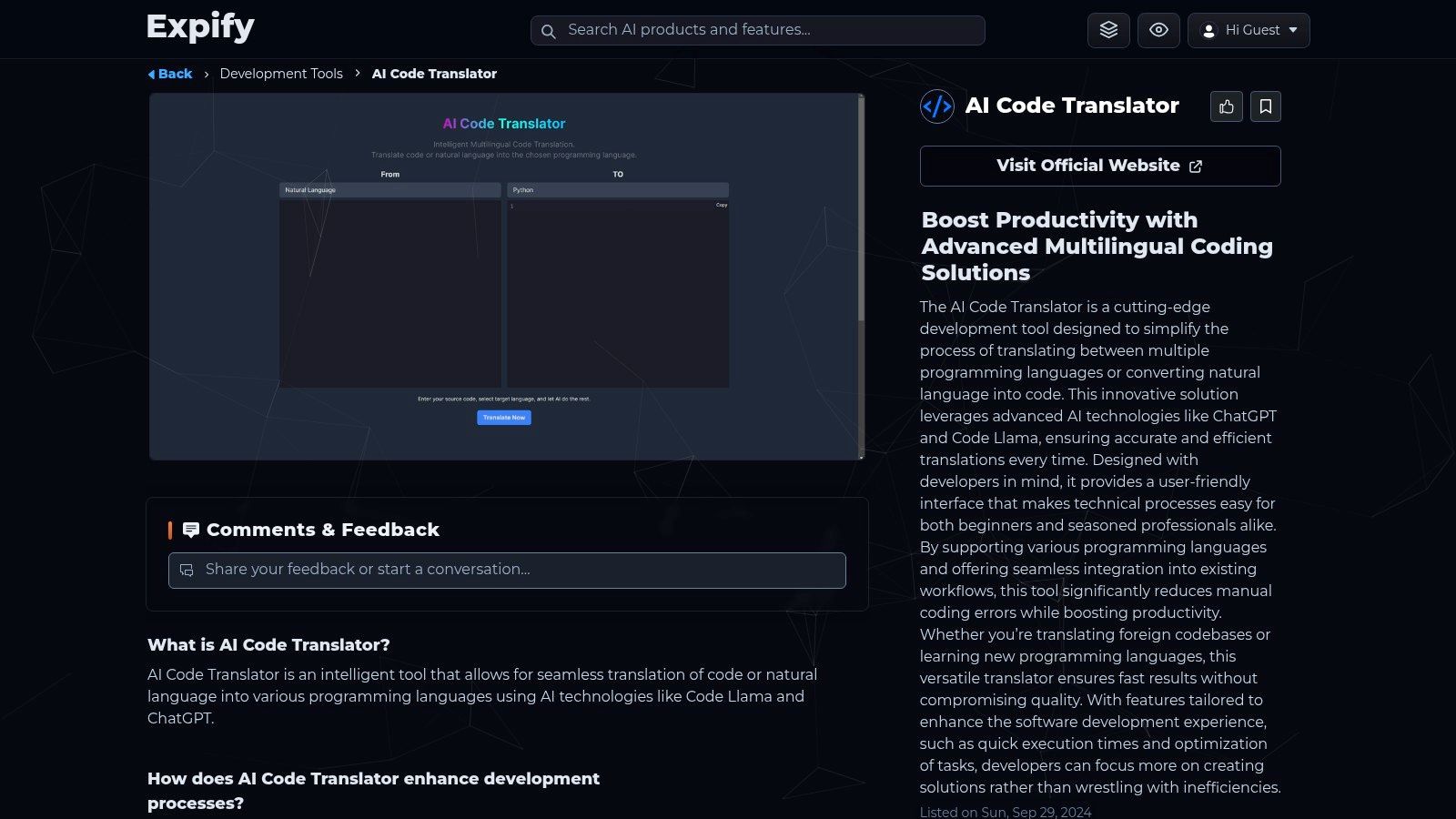Discover the top 12 AI code translator tools for 2025. Compare features, pricing, and use cases to find the best tool for your development projects.
In a development environment characterized by diverse technology stacks and the constant need to modernize, rewriting code between programming languages is a major bottleneck. The manual process is notoriously slow, resource-intensive, and a common source of critical bugs. An effective code translator directly addresses this challenge, offering a powerful solution for migrating applications, integrating systems, or simply understanding a foreign codebase.
These sophisticated tools move beyond basic syntax conversion, leveraging AI to interpret context, maintain algorithmic integrity, and translate complex business logic with high fidelity. For development teams, this translates into significantly accelerated project timelines and reduced error rates. A significant challenge code translators address is simplifying the often complex process of strategies for migrating legacy applications, turning what was once a multi-month endeavor into a more manageable task.
This comprehensive guide analyzes the top 12 code translator platforms available today. We will evaluate each tool’s core features, supported languages, ideal use cases, and limitations to help you find the best fit for your specific project requirements. Each entry includes detailed analysis, screenshots, and direct links so you can get started immediately.
DocuWriter.ai stands out as a comprehensive AI-powered development suite that goes far beyond simple translation. While its core strength lies in automating software documentation, its integrated code translator capability is a powerful, context-aware tool for modernizing legacy systems or migrating projects between languages. This platform excels by not just converting syntax but understanding the underlying logic, ensuring the translated code maintains its original functionality and structure.
For developers and engineering teams, this means a more reliable and efficient migration process. Instead of a piecemeal, line-by-line conversion, DocuWriter.ai provides a holistic solution that integrates translation directly into the development workflow, supported by features like automated documentation and UML diagram generation for the newly converted code.
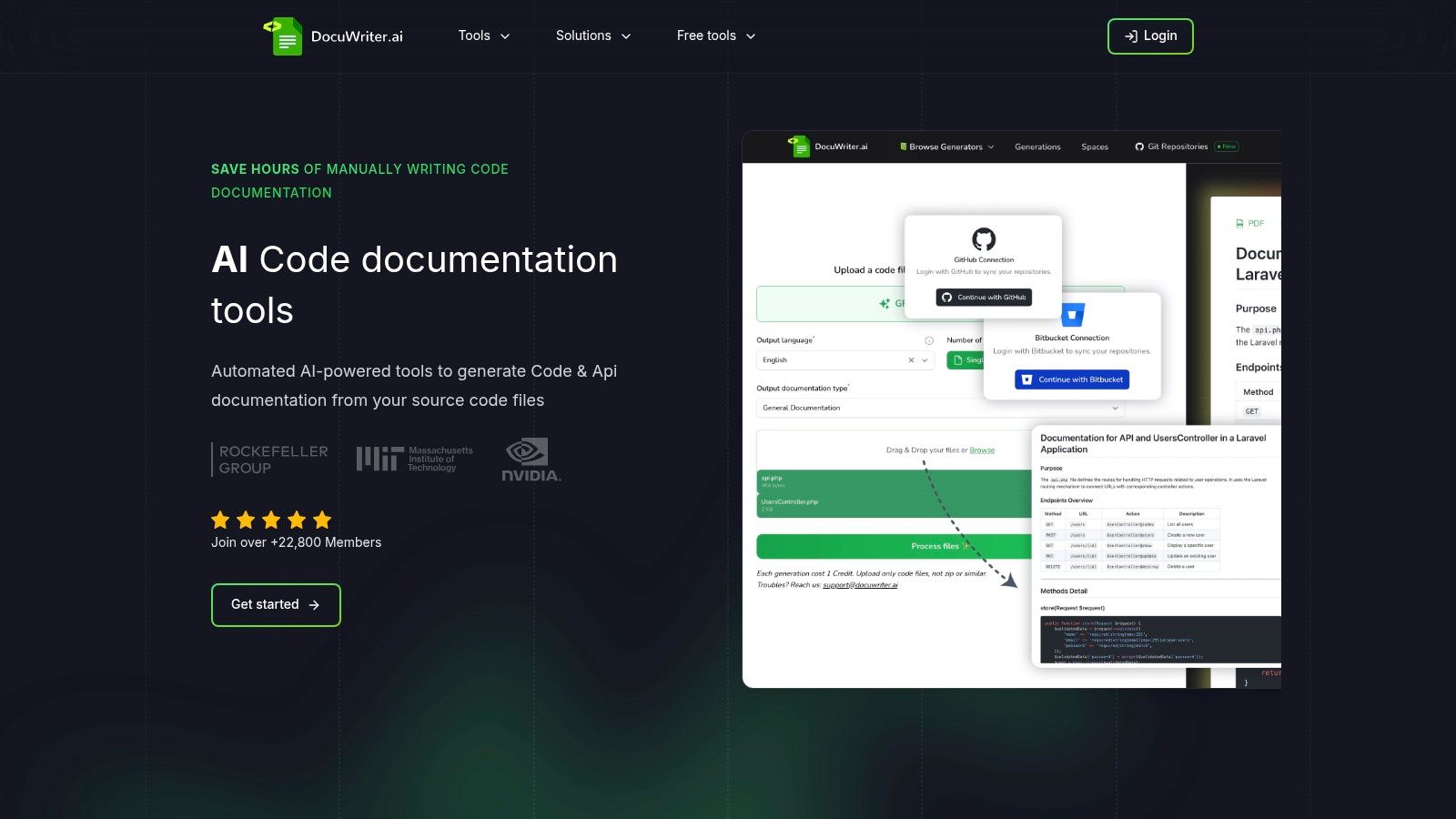
DocuWriter.ai is ideal for enterprise-level projects involving legacy system modernization. A team tasked with converting a large Java 7 application to a more current version of Java or even to Python could use the platform to perform the bulk of the code conversion. Subsequently, they can use the same tool to automatically document the new API endpoints and refactor inefficient code blocks identified by the AI.
DocuWriter.ai operates on a subscription model, ensuring accessibility for different user scales. Plans range from a Starter option at 166/year, designed for large teams and enterprises requiring extensive use and advanced features like team management. While lower-tier plans have generation caps, the pricing structure provides a scalable entry point.
SHIFT™ TRANSLATOR, available through the AWS Marketplace, is a specialized code translator designed for a very specific, high-stakes use case: migrating legacy data warehouses. It excels at automating the conversion of complex SQL, stored procedures, and other database scripts from systems like Teradata and Netezza to modern cloud platforms such as AWS Redshift or Snowflake.
This tool stands out for its enterprise-grade focus. Unlike general-purpose converters, SHIFT™ claims over 98% automation, which significantly accelerates large-scale migration projects and minimizes the human error inherent in manual rewrites. It’s built for handling massive codebases, making it a powerful asset for enterprises looking to modernize their data infrastructure without a complete manual overhaul.
The primary strength of SHIFT™ is its deep specialization. It’s not a tool for converting Python to Java; for those tasks, you’d be better served by exploring resources on different language conversions, like this guide on Java to Python converters. Instead, it’s a precision instrument for a complex database migration.
Visit SHIFT™ TRANSLATOR on AWS Marketplace
HSuperTools offers a free, AI-powered code translator that stands out for its accessibility and broad language support. It caters to developers and students who need quick, on-the-fly conversions between popular languages like Python, Java, JavaScript, C++, and PHP. The tool is designed for immediate use, requiring no sign-up or complex setup to get started.
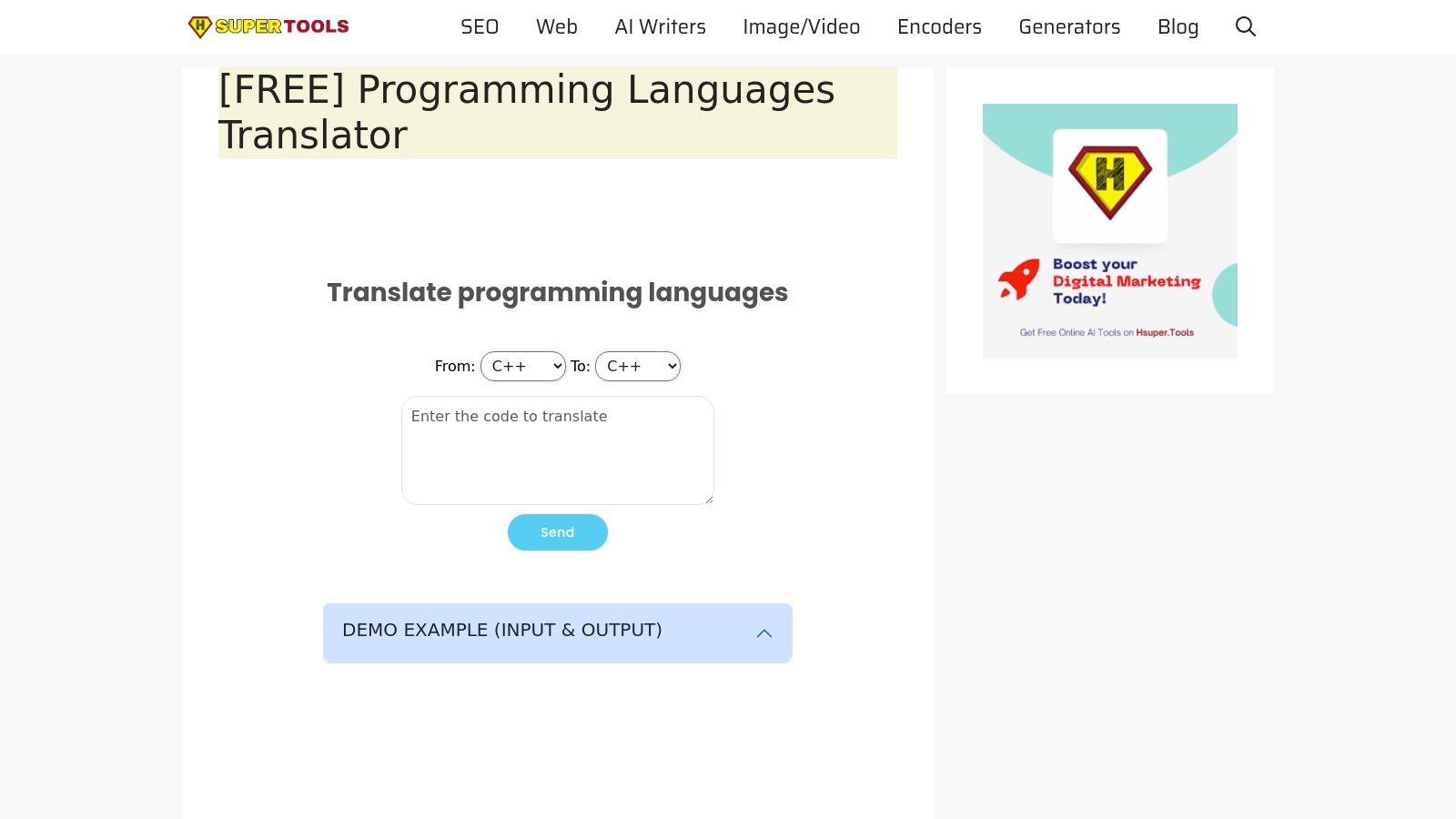
This platform’s main draw is its simplicity and cost-effectiveness. By focusing on instant, no-barrier translation, it serves a different niche than enterprise-grade migrators. It prioritizes preserving core logic and functionality during conversion, making it a valuable utility for learning a new language syntax or for porting smaller code snippets and algorithms between projects.
The core strength of HSuperTools is its zero-cost, instant-access model. While it may not handle vast, enterprise-level codebases with perfect nuance, it excels at smaller, well-defined tasks. For more context on how different translators handle various languages, you can explore resources that provide a broader view on the subject, like this overview of programming language translators. It’s a pragmatic tool for everyday developer needs.
DeveloperPal offers a modern, AI-powered code translator that emphasizes developer productivity and contextual accuracy. It supports a broad spectrum of popular languages, including Python, Java, JavaScript, and C++, making it a versatile tool for everyday coding tasks, from small snippets to entire files.
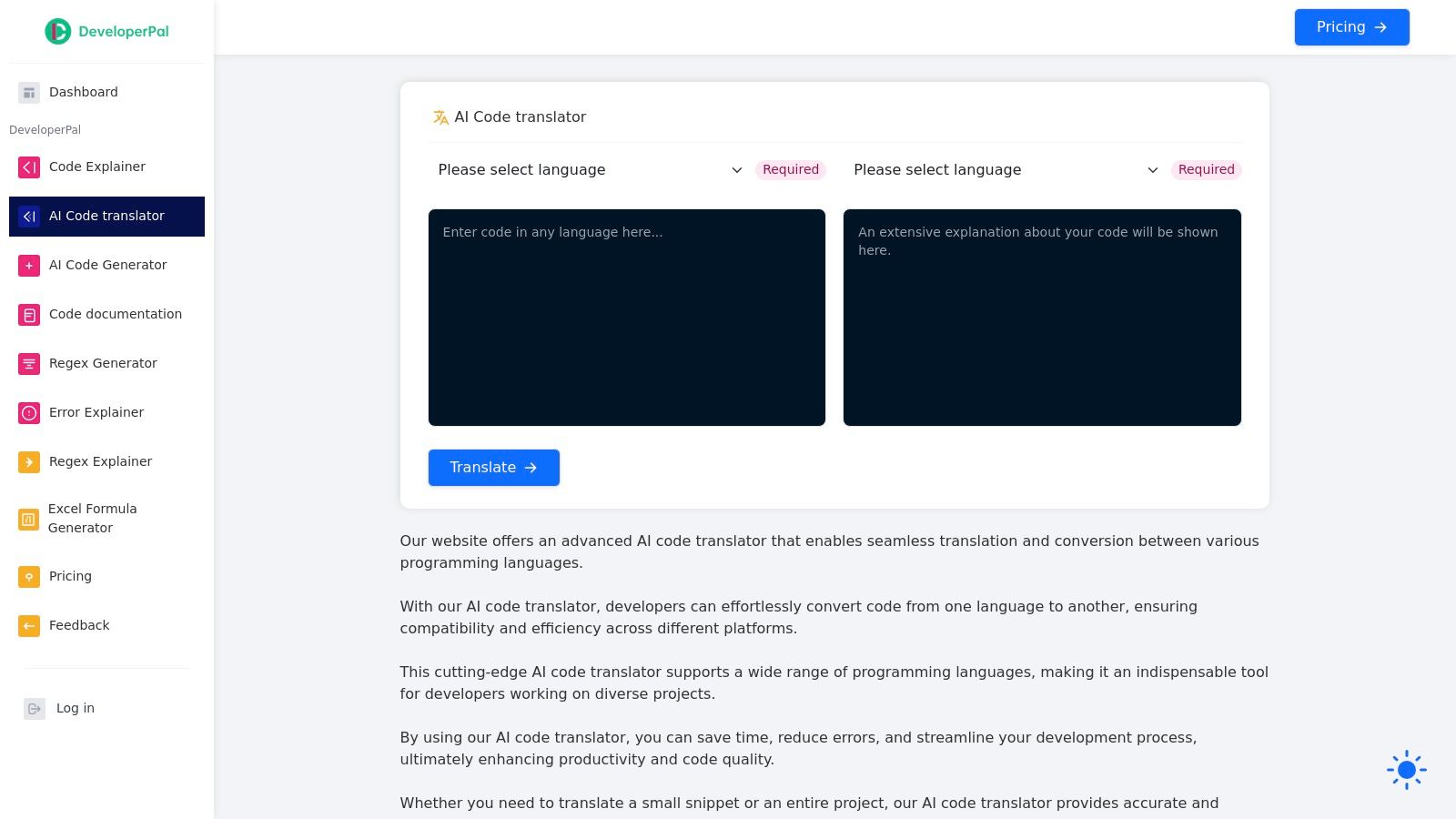
What sets DeveloperPal apart is its focus on the developer experience. The platform features a user-friendly interface with batch processing, allowing you to convert multiple files at once. Its AI is designed to be context-aware, striving to produce more accurate and idiomatic translations while preserving crucial comments and documentation, which is often lost in simpler converters.
DeveloperPal’s strength lies in its balance between versatility and intelligence. It’s not just a direct syntax swapper; its context-awareness aims to reduce the manual cleanup required after translation. This positions it as a powerful assistant for both learning a new language and for modernization projects that involve more than just database scripts. For those interested in how AI can improve existing code, exploring the concepts of AI-driven code refactoring provides valuable related insights.
Visit DeveloperPal: AI Code Translator
While not a conventional code translator, TransTools+ earns its place on this list by addressing a critical adjacent task: managing and cleaning documents that often contain code snippets, logs, and technical text. It operates as a productivity suite within Microsoft Word, designed to streamline complex document formatting and correction tasks that developers and technical writers frequently encounter. Its primary function is not to convert programming languages but to prepare technical documentation for translation or publication.
This tool excels at tasks like running multiple find-and-replace operations simultaneously, correcting spacing and punctuation inconsistencies, and preparing documents for Desktop Publishing (DTP). For a developer documenting an API or a team localizing a user manual, TransTools+ automates the tedious cleanup process, ensuring consistency across large files that might contain mixed content, including code.
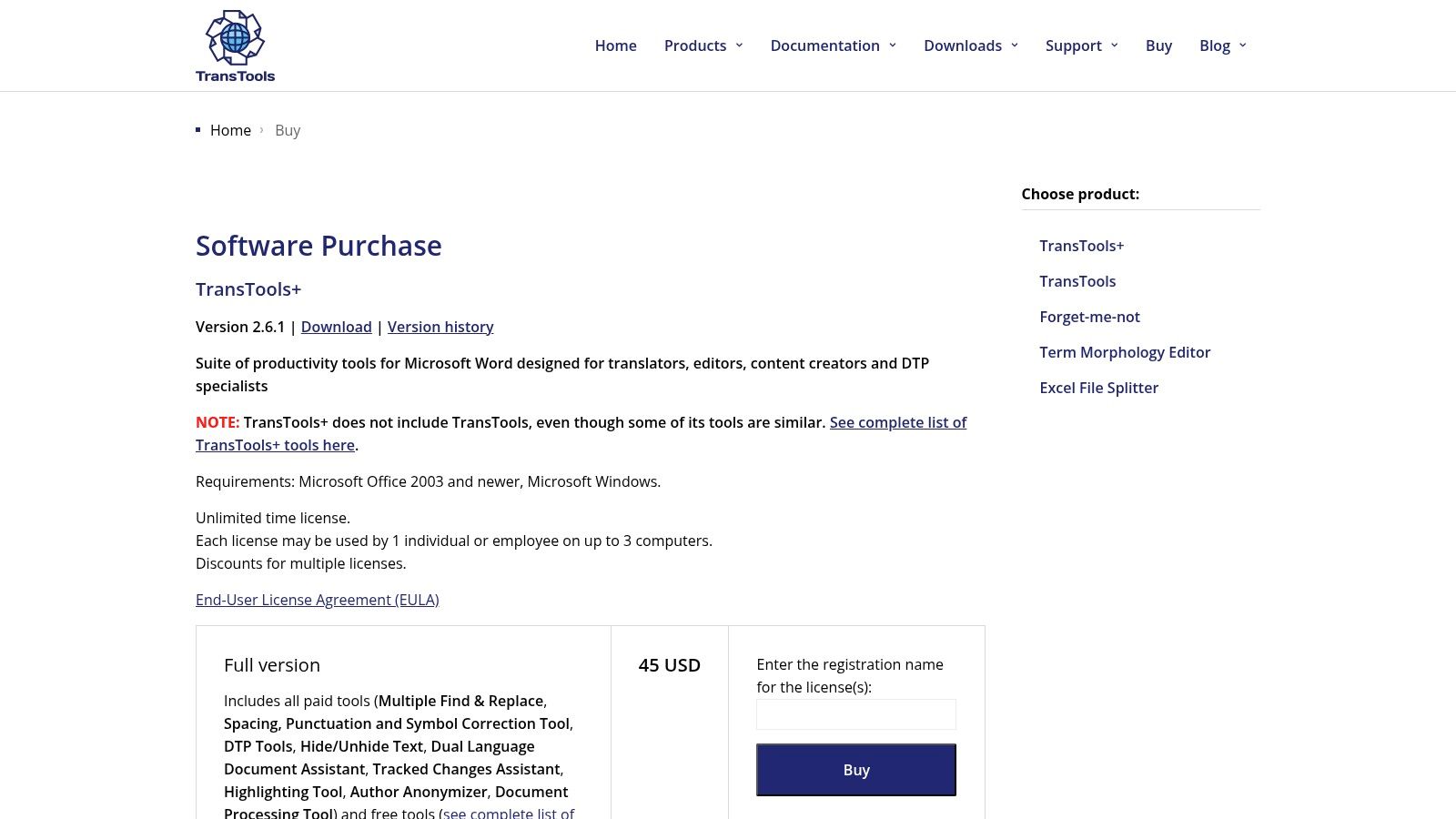
The core strength of TransTools+ is its highly specific focus on document workflow optimization rather than code logic conversion. It’s a specialized instrument for developers who must produce high-quality documentation, not a tool for migrating a codebase from one language to another. It handles the “last mile” of technical content preparation with precision.
Instead of a single tool, Top AI Tools provides a meta-resource: a curated directory of over 70 AI-powered code translator applications. It serves as an aggregator, offering a centralized place for developers to discover, compare, and select the right tool for their specific needs. The platform compiles both free and paid options, complete with descriptions, user ratings, and direct links.
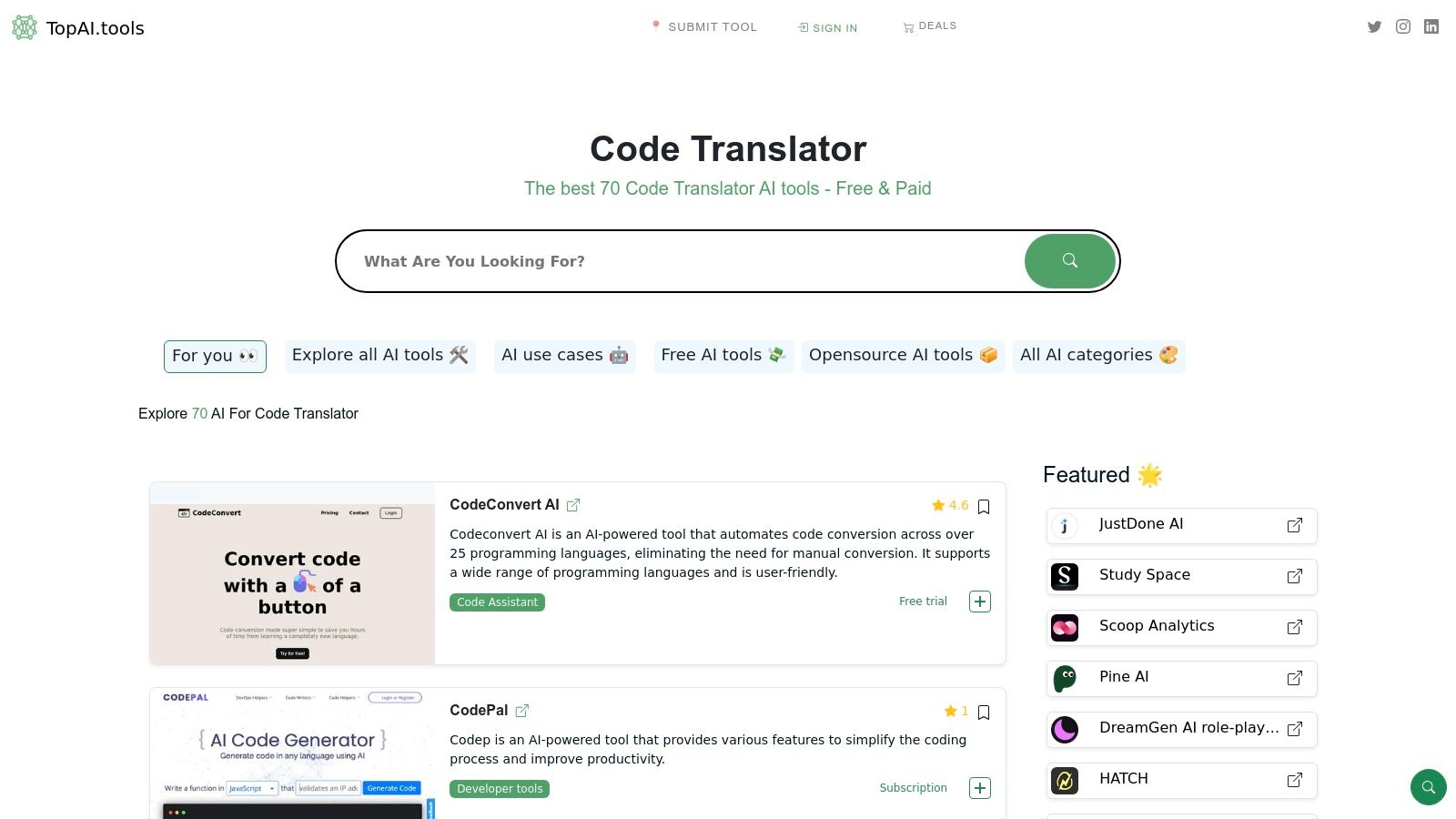
This directory’s value lies in its breadth and user-driven feedback. Rather than developers relying on scattered search results, Top AI Tools consolidates the landscape, allowing for a more efficient and informed decision-making process. For comprehensive AI-powered coding assistance, including capabilities that aid in code generation and adaptation across languages, consider tools like Github Copilot which you might find listed among similar resources.
Top AI Tools is not a translator itself but an essential starting point for your research. Its strength is in saving developers significant time by presenting a wide array of specialized and general-purpose converters in one organized view.
Visit Top AI Tools: Code Translator
WithTranslation offers a refreshingly simple and accessible code translator powered by modern AI. It leverages GPT-3.5 and GPT-4 to provide instant code conversions directly in the browser, supporting popular languages like Python, JavaScript, Java, and C#. The platform is designed for quick, one-off translation tasks without the friction of user registration or payment.
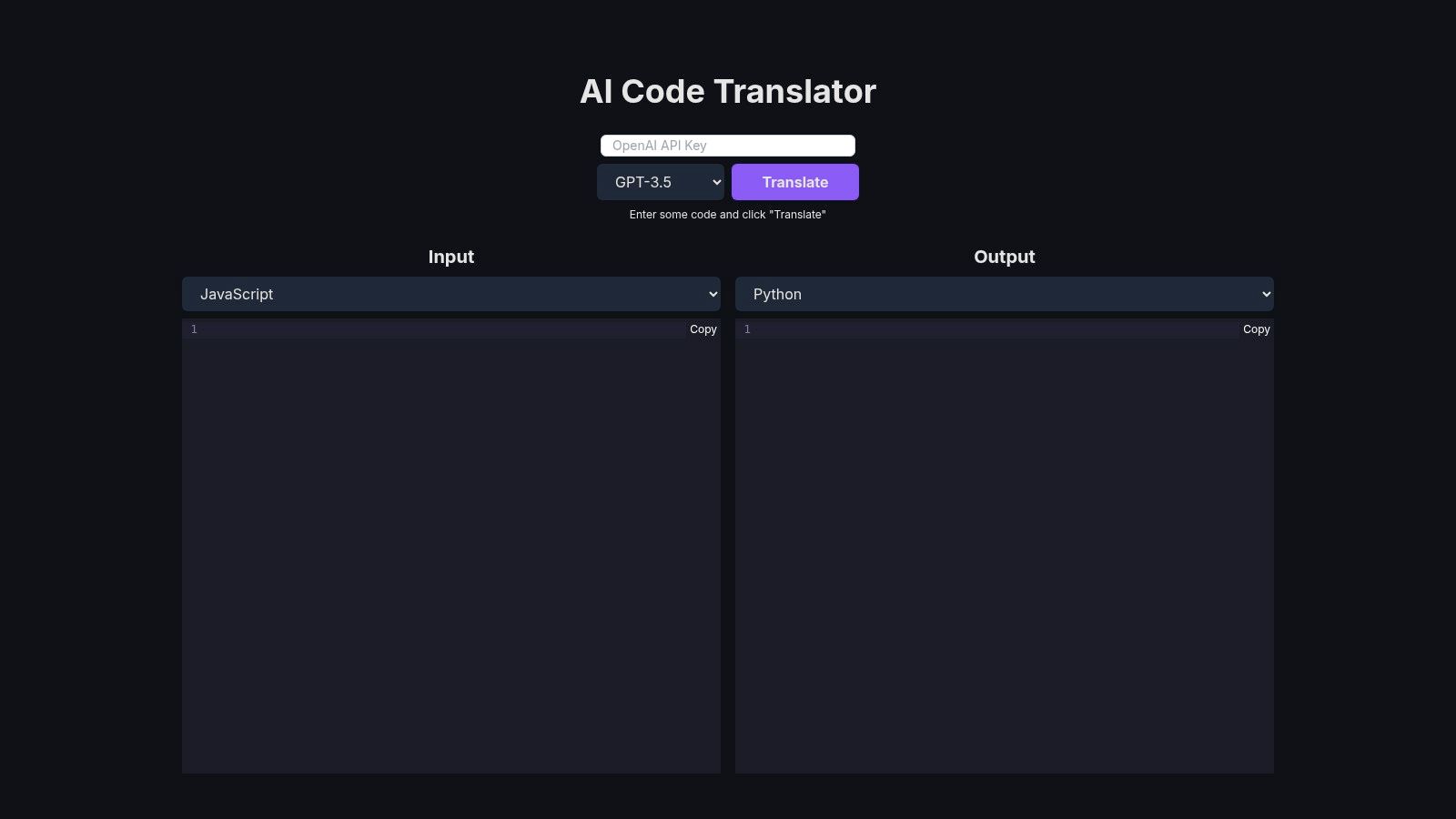
This tool stands out for its directness and ease of use. Developers can simply paste their source code, select the target language, and receive the converted snippet in seconds. Its reliance on powerful large language models means it can often handle idiomatic expressions and common library usage, making it a valuable utility for prototyping, learning a new language, or refactoring small components.
The primary strength of WithTranslation is its no-barrier accessibility. It’s the digital equivalent of a quick lookup tool, perfect for developers who need an immediate translation without committing to a platform or a paid service. The minimalist interface ensures that the focus remains entirely on the code conversion task.
Visit WithTranslation: Code Translator
Spyce offers an AI-driven code translator that balances user-friendliness with powerful features, making it a strong contender for everyday development tasks. It supports a wide range of popular languages, including JavaScript, Python, Java, and C#, catering to the needs of modern web and application developers. The platform distinguishes itself by offering API access, allowing teams to integrate its translation capabilities directly into their development workflows or custom applications.
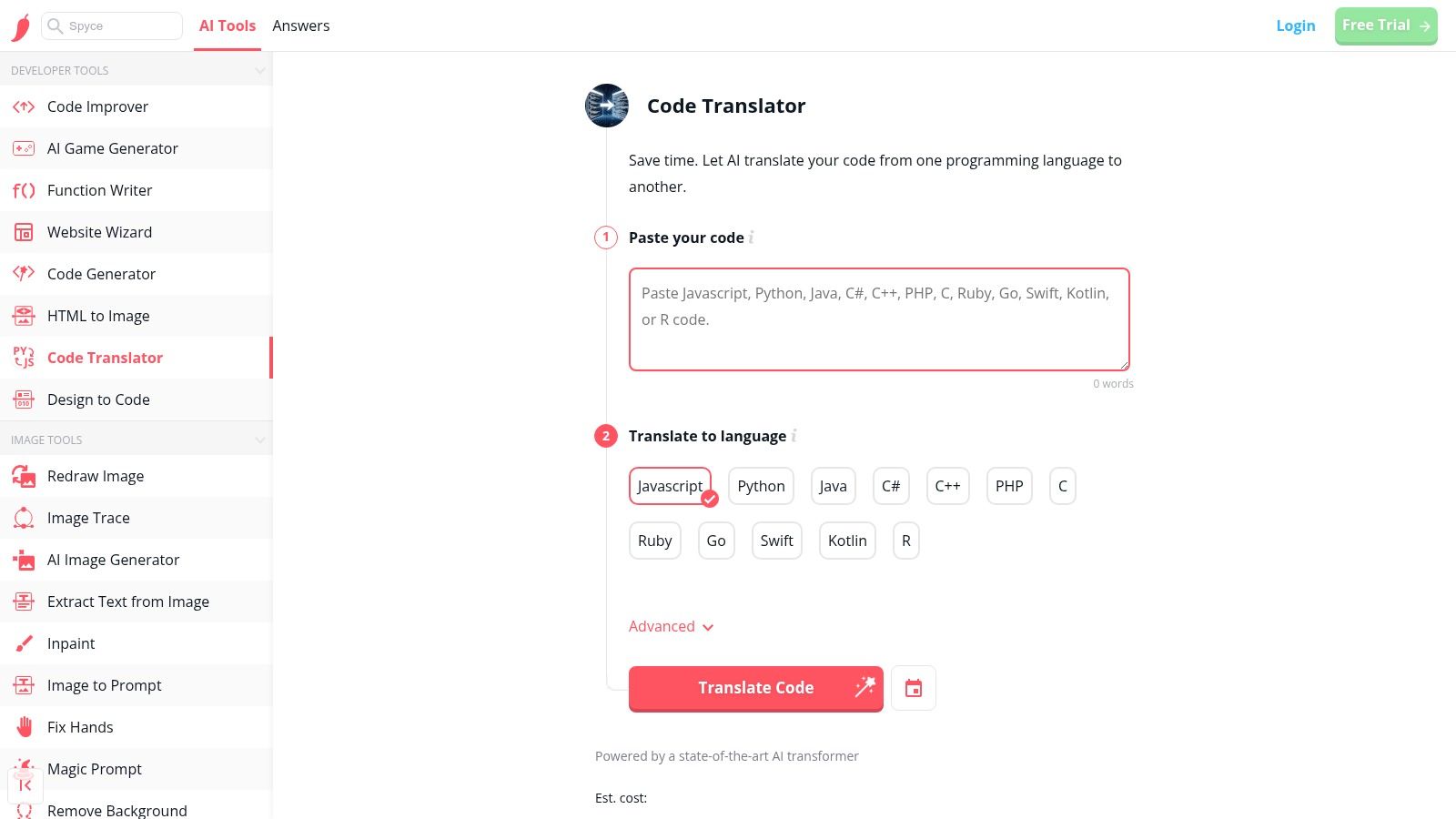
The clean, minimalist interface makes Spyce highly approachable for quick conversions. While it provides advanced options for handling more complex code, its core strength lies in its accessibility and versatility for a broad developer audience, from freelancers to small engineering teams looking for a reliable, on-demand translation tool.
Spyce is an excellent general-purpose tool, particularly for developers who need to frequently switch between different programming languages. Its API is a key differentiator, opening up possibilities for programmatic code conversion that many free online tools lack. The membership model, while a limitation, gates access to its full potential.
Musely offers a versatile and free code translator powered by AI, targeting developers who need quick conversions across common programming languages. It supports popular choices like Python, Java, JavaScript, and C++, making it a practical tool for everyday coding tasks, such as refactoring a function from one language to another or learning a new language by seeing direct translations of familiar code.
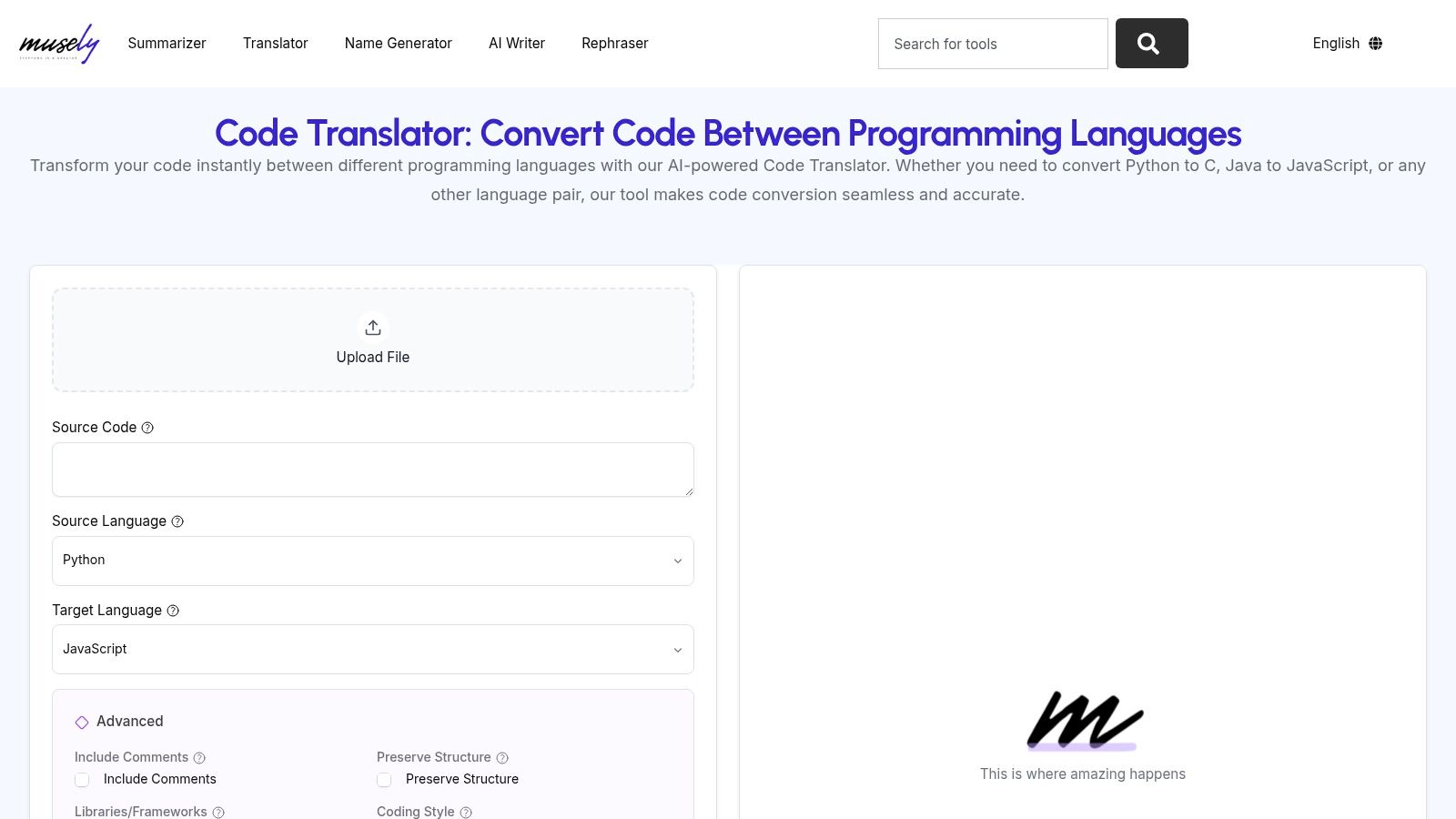
What sets Musely apart is its inclusion of advanced features typically found in paid tools. It provides intelligent syntax optimization to improve the quality of the output, real-time error detection, and a batch processing capability. This batch feature is especially useful for translating multiple files or code snippets at once, significantly boosting a developer’s productivity.
Musely’s primary strength is its accessibility and robust feature set for a free tool. It strikes an excellent balance between a simple, easy-to-use interface and powerful functionalities like custom translation rules, which allow developers to fine-tune the conversion logic for specific project needs.
Visit Musely: AI Code Translator
Expify offers an AI-driven code translator designed to simplify modern development workflows by converting code across multiple languages. A standout feature is its ability to interpret natural language descriptions and generate corresponding code, positioning it as a versatile assistant for both translation and initial code creation.
The platform focuses on enhancing developer productivity and streamlining integration into existing processes. By automating routine conversions, Expify aims to reduce manual coding errors and accelerate development cycles, making it a practical tool for daily coding tasks.
